AUDI A5 CABRIOLET 2015 Owners Manual
Manufacturer: AUDI, Model Year: 2015, Model line: A5 CABRIOLET, Model: AUDI A5 CABRIOLET 2015Pages: 268, PDF Size: 66.88 MB
Page 221 of 268
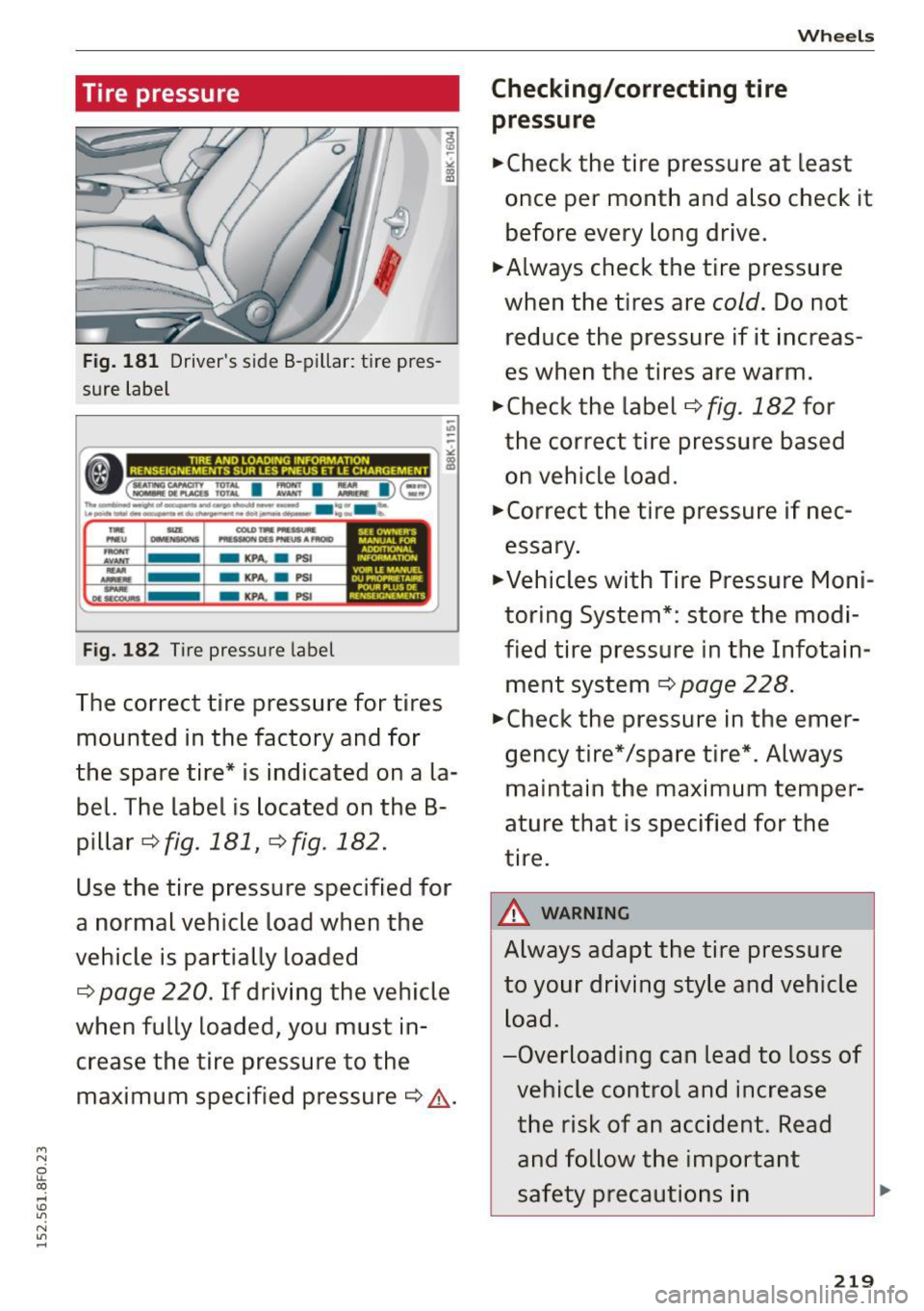
M N 0 u. ~ ..... \D V
N V .....
Tire pressure
Fig. 181 Driver' s side B-pillar : tire pres
sure label
"' -,,-------------------- ,.
9c:=:=. ~_:: I =:: I :.. I)@ :l! n. ...... _..,_ ... ___ ......, ____ .... _ ..
ui ............... ~-.... ~ .... .... ...
TR IIZI. 00lO TW.PMSIUl'll '""' ONiNSIC)N$ ,...._0UntlUSAN1011
-KPA. . PSI
Fig. 182 T ire pressure label
The correct tire pressure for tires
mounted in the factory and for
the spare tire* is indicated on a la
bel. The labe l is located on the 8-
pillar
¢fig. 181, ¢fig. 182.
Use the tire pressure specified for
a normal vehicle load when the
vehicle is partially loaded ¢
page 220. If driving the vehicle
when fully loaded, you must in crease the tire pressure to the
maximum specified pressure¢
A-
Checking/correcting tire
pressure
Wheels
.. Check the tire pressure at least
once per month and also check it before every long drive .
.. Always check the tire pressure
when the tires are
cold. Do not
reduce the pressure if it increas
es when the tires are warm.
.. Check the label¢
fig. 182 for
the correct tire pressure based on vehicle load.
..Correct the tire pressure if nec
essary .
.. Vehicles with Tire Pressure Moni
tor ing System*: store the modi
fied tire pressure in the Infotain
ment system¢
page 228.
.. Check the pressure in the emer
gency tire* /spare t ire*. Always
ma intain the maximum temper
ature that is specified for the
tire.
A WARNING
-
Always adapt the tire pressure
to your driving style and vehicle load.
-Overloading can lead to loss of vehicle control and increase
the risk of an accident. Read
and follow the important
safety precautions in
219
Page 222 of 268
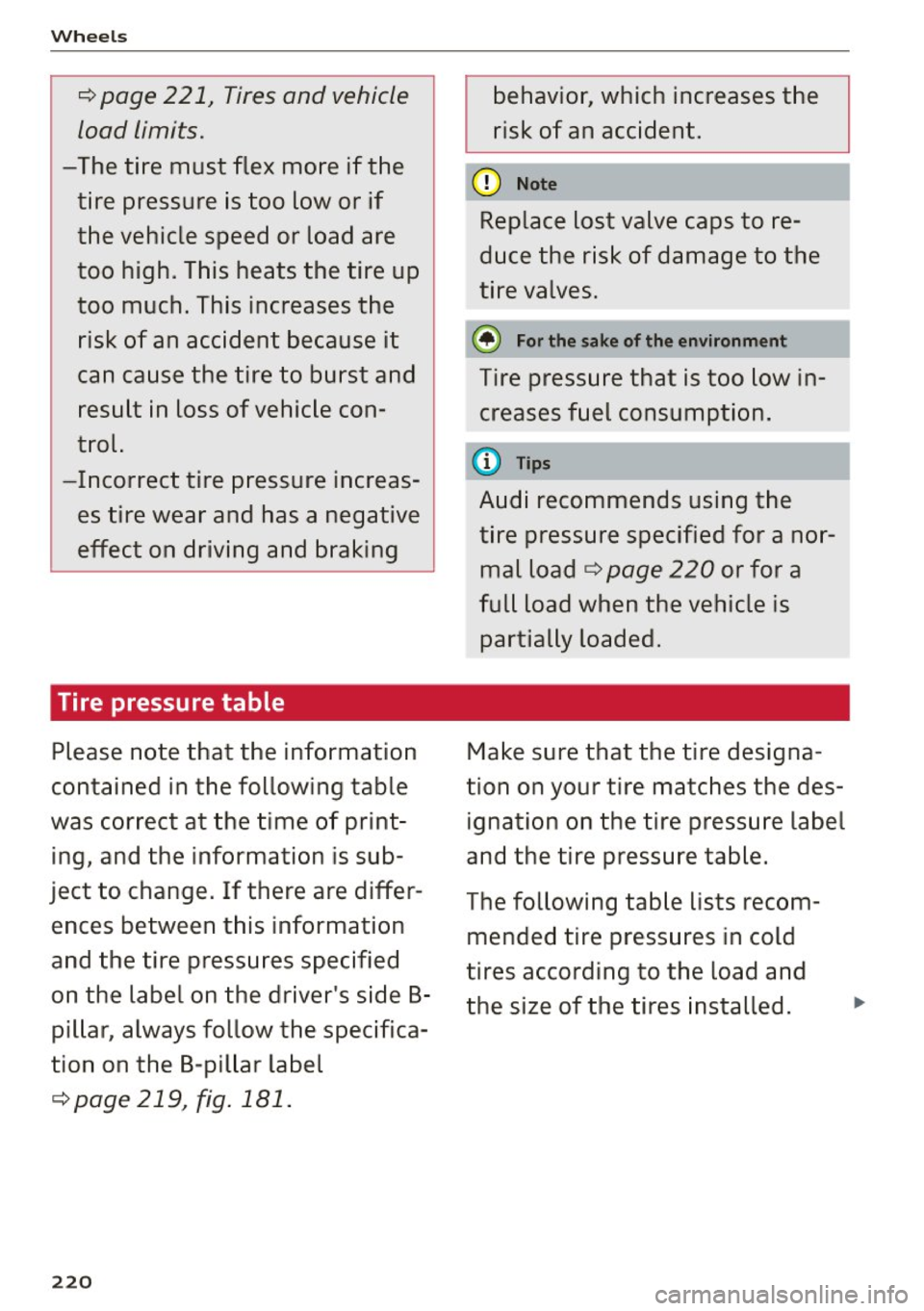
Wheels
c:::> page 221, Tires and vehicle
load limits.
-The tire must flex more if the tire pressure is too low or if
the vehicle speed or load are
too high. This heats the tire up
too much. This increases the
risk of an accident because it
can cause the tire to burst and
result in loss of vehicle con
trol.
-Incorrect tire pressure increas
es tire wear and has a negative
effect on driving and braking
Tire pressure table
Please note that the information
contained in the following table
was correct at the time of print
ing, and the information is sub
ject to change. If there are differ ences between this information
and the tire pressures specified
on the label on the driver's side 8-pillar , always follow the specifica
tion on the 8-pillar label
c:::> page219, fig.181.
220
behavior, which increases the
risk of an accident.
(D Note
Replace lost valve caps to re
duce the risk of damage to the
tire valves.
@ For the sake of the environment
Tire pressure that is too low in
creases fuel consumption.
(D Tips
Audi recommends using the
tire pressure specified for a nor
mal load
c:::> page 220 or for a
full load when the vehicle is
partially loaded.
Make sure that the tire designa
tion on your tire matches the des ignation on the tire pressure label
and the tire pressure table.
The following table lists recom mended tire pressures in cold
tires according to the load and the size of the tires installed. .,.
Page 223 of 268
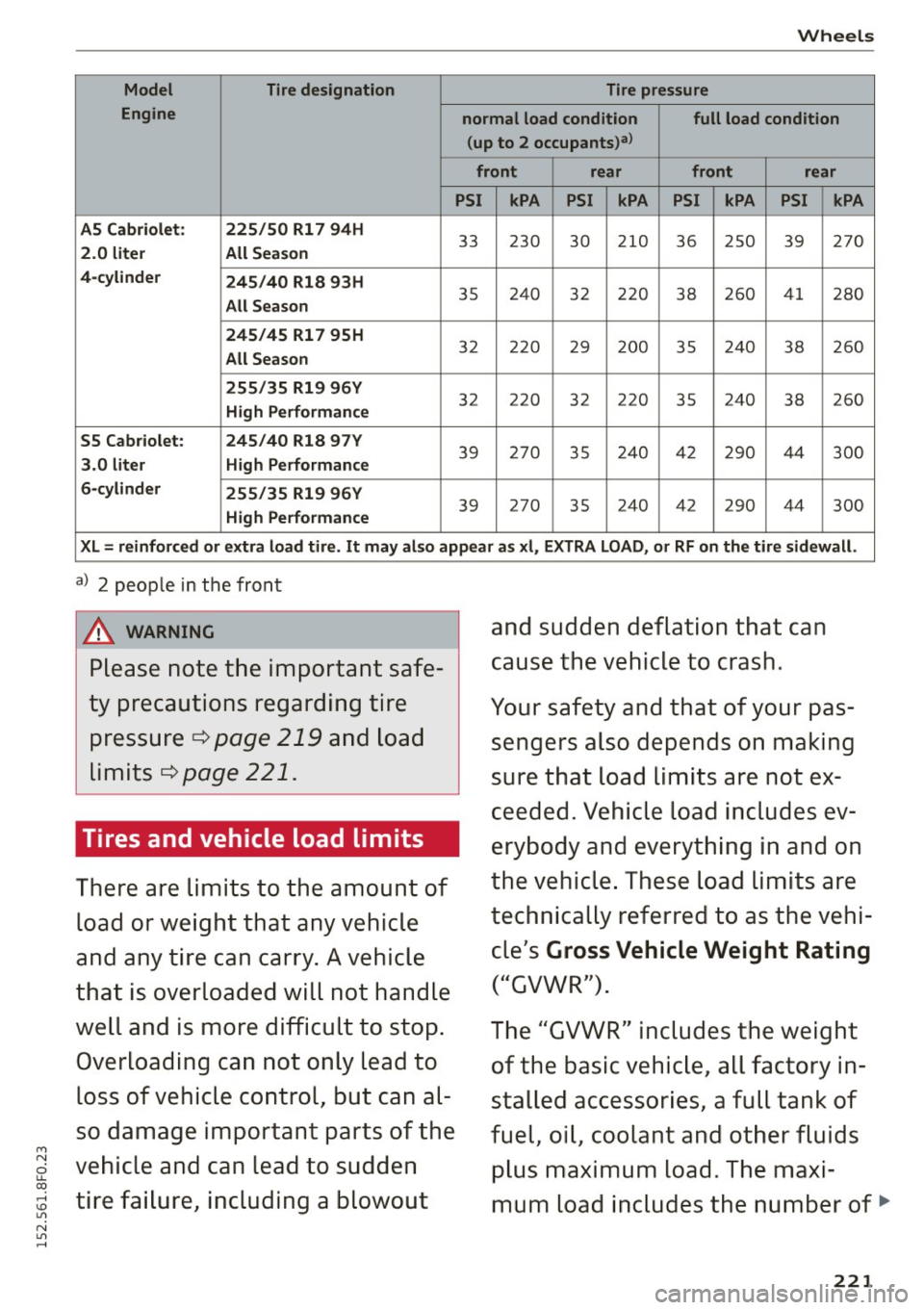
M N
ci u.. co ,...., \!) 1.1'1
N 1.1'1 ,....,
Wheels
Model Tire designation Tire pressure
Engine normal load condition full load condition
(up to 2 occupants)a)
front rear front rear
PSI kPA PSI kPA PSI kPA PSI kPA
AS Cabriolet: 225/50 Rl 7 94H
33 230 30 210 36 250 39 270 2.0 liter All Season
4-cylinder 245/40 Rl8 93H
All Season
35 240 32 220 38 260 41 280
245/45 Rl7 95H 32 220 29 200
35 240
38 260
All Season
255/35 Rl9 96Y
32 220 32 220 35 240
38 260 High Performance
SS Cabriolet: 245/40 Rl8 97V
39 270 35 240 42 290 44 300 3.0 liter High Performance
6-cylinder
255/35 Rl9 96V
High Performance
39 270
35 240 42 290 44 300
XL= reinforced or extra load tire. It may also appear as xl, EXTRA LOAD, or RF on the tire sidewall.
a) 2 people
in the front
A WARNING
Please note the important safe
ty precautions regarding tire pressure ¢
page 219 and load
limits
¢ page 221.
Tires and vehicle load limits
There are limits to the amount of
load or weight that any vehicle
and any tire can carry. A vehicle
that is overloaded will not handle
well and is more difficult to stop. Overloading can not only lead to
loss of vehicle control, but can al
so damage important parts of the
vehicle and can lead to sudden
tire failure, including a blowout and
sudden deflation that can
cause the vehicle to crash.
Your safety and that of your pas sengers also depends on making
sure that load limits are not ex
ceeded. Vehicle load includes ev
erybody and everything in and on
the vehicle. These load limits are
technically referred to as the vehi cle's
Gross Vehicle Weight Rating
("GVWR").
The "GVWR" includes the weight of the basic vehicle, all factory in
stalled accessories, a full tank of
fuel, oil, coolant and other fluids plus maximum load. The maxi
mum load includes the number of
1111-
221
Page 224 of 268
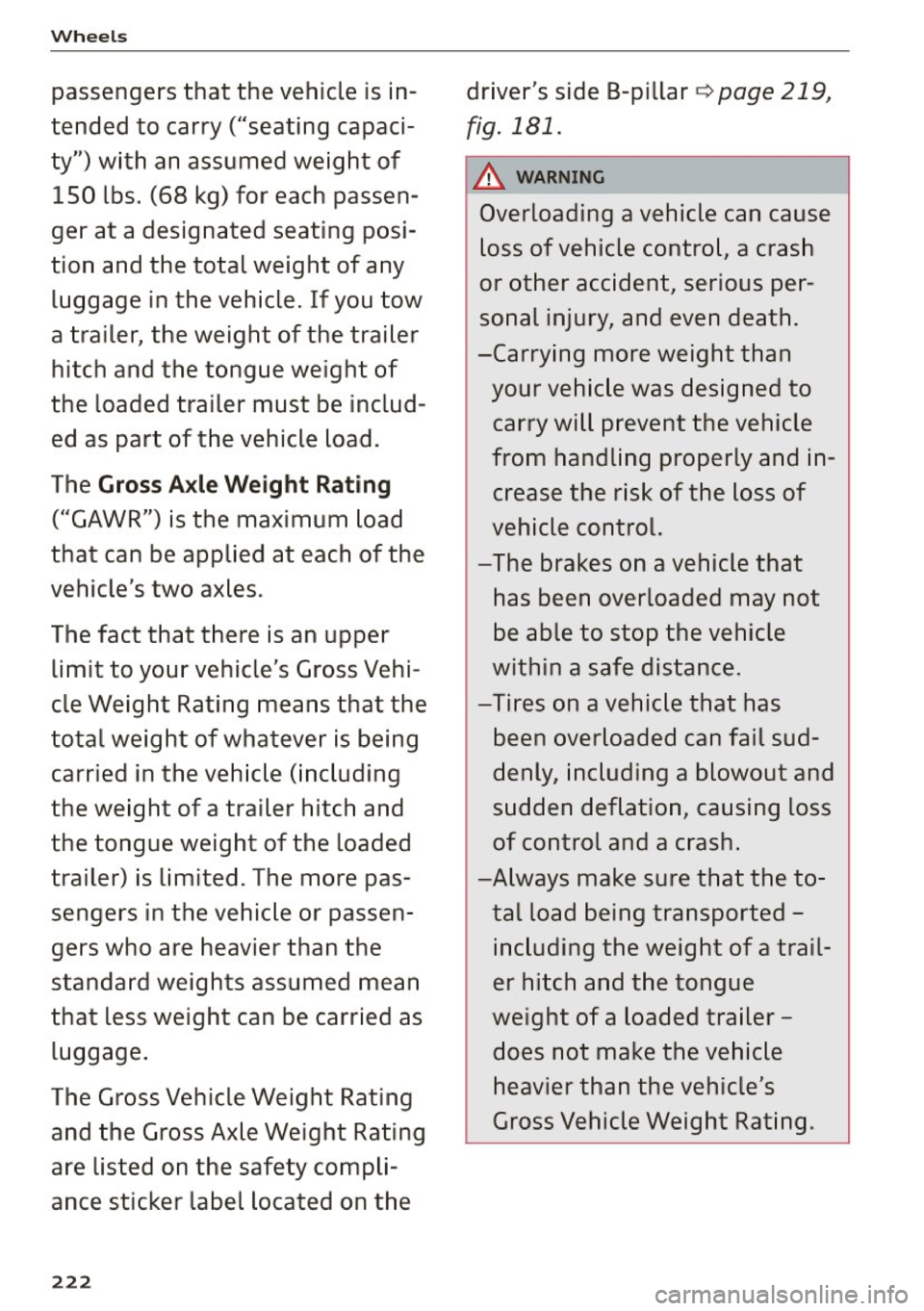
Wheels
passengers that the vehicle is in
tended to carry ("seating capaci
ty") with an assumed weight of 150 lbs. (68 kg) for each passen
ger at a designated seating posi
tion and the total weight of any
luggage in the vehicle. If you tow
a trailer, the weight of the trailer
hitch and the tongue weight of
the loaded trailer must be includ
ed as part of the vehicle load.
The
Gross Axle Weight Rating
("GAWR") is the maximum load
that can be applied at each of the
vehicle's two axles.
The fact that there is an upper limit to your vehicle's Gross Vehi
cle Weight Rating means that the
total weight of whatever is being
carried in the vehicle (including
the weight of a trailer hitch and
the tongue weight of the loaded
trailer) is limited. The more pas
sengers in the vehicle or passen
gers who are heavier than the
standard weights assumed mean
that less weight can be carried as
luggage.
The Gross Vehicle Weight Rating
and the Gross Axle Weight Rating
are listed on the safety compli
ance sticker label located on the
222
driver's side B-pillar ~ page 219,
fig. 181.
~ WARNING
Overloading a vehicle can cause
loss of vehicle control, a crash
or other accident, serious per
sonal injury, and even death.
-Carrying more weight than your vehicle was designed to carry will prevent the vehicle
from handling properly and in
crease the risk of the loss of
vehicle control.
-The brakes on a vehicle that
has been overloaded may not
be able to stop the vehicle
within a safe distance.
-Tires on a vehicle that has
been overloaded can fail sud
denly, including a blowout and
sudden deflation, causing loss
of control and a crash.
-A lways make sure that the to
tal load being transported -
including the weight of a trail
er hitch and the tongue
weight of a loaded trailer -
does not make the vehicle
heavier than the vehicle's
Gross Vehicle Weight Rating.
Page 225 of 268

M N
ci u.. co ,...., \!) 1.1'1
N 1.1'1 ,....,
Determining correct load
limit
Use the example below to calcu
late the total weight of the pas
sengers and luggage or other
things that you plan to transport
so that you can make sure that
your vehicle will not be overload ed.
Steps for Determining Correct Load Limit
1. Locate the statement "THE
COMBINED WEIGHT OF OCCUPANTS AND CARGO SHOULD
NEVER EXCEED XXX KG OR XXX
LBS"on your vehicle's placard
(tire inflation pressure label)
¢page 219, fig. 181.
2. Determine the combined
weight of the driver and pas
sengers that will be riding in
your vehicle.
3. Subtract the combined weight of the driver and passengers
from
"XXX" kilograms or "XXX"
pounds shown on the sticker
¢page 219, fig. 181.
4. The resulting figure equals the
available amount of cargo and luggage load capacity. For ex
ample, if the
"XXX" amount
equals 1400 lbs. and there will
Wheels
be five 1 SO lbs. passengers in
your vehicle, the amount of available cargo and luggage load capacity is 650 lbs.
(1400-750 (5 X 150) = 650
lbs.)
5. Determine the combined
weight of luggage and cargo
being loaded on the vehicle.
That weight may not safely ex
ceed the available cargo and
luggage load capacity calculat
ed in Step 4.
6. If your vehicle will be towing a trailer, load from your trailer
will be transferred to your vehi
c le. Consult this manual to de
termine how this reduces the
available cargo and luggage load capacity of your vehicle.
.,.Check the tire sidewall
(¢ page 209, fig. 179) to deter
mine the designated load rating
for a specific tire.
Wheel bolts and rims
Wheel bolts
Wheel bolts must be clean and loosen/tighten
easily.
Rims
Rims with a bolted rim ring* or with bolted wheel
cov ers* consist of multiple pieces. These compo
nents were bolted together using special bolts
and a special procedure . You must not repair or
disassemble them
i::> Li::,.. ..,.
223
Page 226 of 268

Wheels
A WARNING
Wheel bolts that are tightened or repaired incorrectly can become loose and result in loss
of vehicle control , which increases the risk of
an accident. For the correct tightening specifi
cation, refer to
c:> page 231, After changing a
wheel.
- Always keep the wheel bolts and the threads
in the wheel hub clean and free of grease.
- Only use wheel bolts that fit the rim .
- Always have damaged rims repaired by an
authorized Audi dealer or authorized repair
facility. Never repair or disassemble rims
yourself, because this increases the risk of an accident.
Winter tires
Winter tires significantly improve the vehicle's handling when driving in winter conditions . Be
cause of their construction (width, compound,
tread pattern), summer tires provide less traction
on ice and snow.
.., Use winter tires on all four wheels .
.., Only use winter tires that are approved for your
vehicle.
.., Please note that the maximum permitted
speed may be lower with winter tires
c:> .&,.
Your authorized Audi dealer or authorized re
pai r facility can inform you about the maximum
permitted speed for your tires .
.., Check the tire pressure after installing wheels
c:> page 219.
The effectiveness of winter tires is reduced great
ly when the tread is worn down to a depth of
0 .1S7 inch (4 mm). The characteristics of winter
tires also decrease greatly as the tire ages, re
gardless of the remaining tread.
A WARNING
-Never drive faster than the maximum per
mitted speed for your t ires. This could cause
the tires to heat up too much . This increases
the risk of an accident because it can cause
the tire to burst.
224
- Always adapt your driving to the road and
traffic conditions. Drive carefully and reduce
your speed on icy or slippery roads. Even
winter tires can lose traction on black ice.
@ For the sake of the environment
Reinstall summer tires at the appropriate
time, because they provide better handling
when roads are free of snow and ice. Summer
tires cause less road noise, tire wear and fuel
consumpt ion.
(D Tips
You can also use all season tires instead of
winter tires. Please note that in some coun
tries where winter tires are required, only win
ter tires w ith the
& symbol may be permit
ted.
· Snow chains
Snow chains improve traction in the snow .
.., Only install snow chains on the front wheels.
This applies also to vehicles with all wheel drive* .
.., Check and correct the seating of the snow
chains if necessary after driving a few feet. Fol
low the instructions from the manufacturer .
.., Note the maximum permitted speed when driv
ing with snow chains . Do not exceed 30 mph
(SO km/h) .
Snow chains not only improve the
driving in win
ter road conditions, but also the
braking.
Use of snow chains is only permitted with certain
rim/tire combinations due to technical reasons.
Check with an authorized Audi dealer or author
ized repair facility to see if you may use snow
chains .
Use
fine-mesh snow chains. They must not add
more than 0.53 inch (13.S mm) in height, includ
ing the chain lock.
You must remove the chains when driving on
roads that are
free of snow. When roads are free
of snow, snow chains can impair handling and .,.
Page 227 of 268
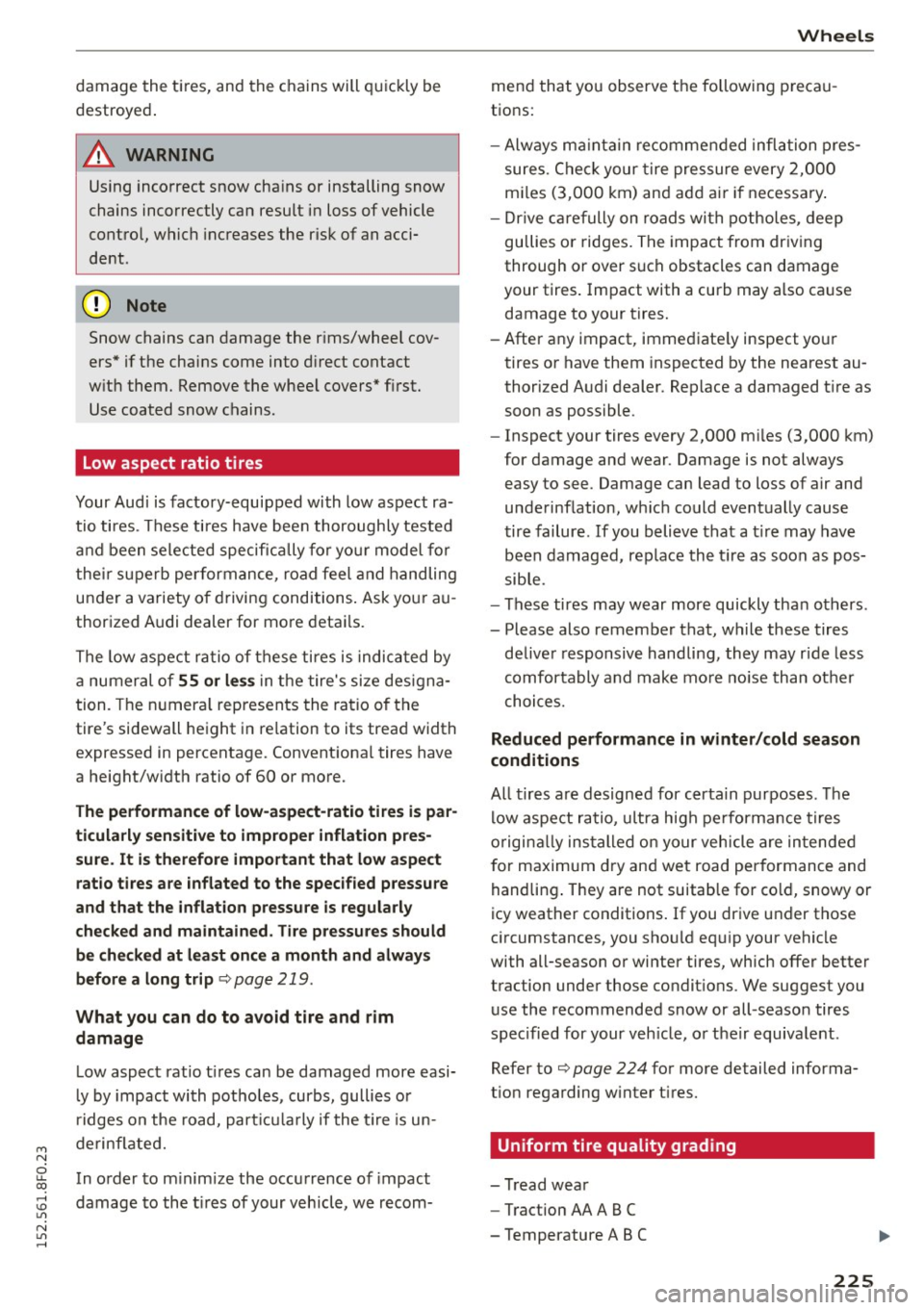
M N
ci u.. co ,...., \!) ..,.,
N ..,., ,....,
damage the t ires, and the c hains will quickly be
destroye d.
A WARNING
Using inco rrect snow cha ins or installing snow
chains incorrectly can resu lt i n loss of vehicle
cont ro l, whic h increases the r isk of an acci
de nt.
(D Note
Snow chains can dama ge the r ims/whee l cov
ers * if th e cha ins come into d irect contact
w it h them. Remove the whee l cov ers* f irst .
Use coat ed snow c hains.
Low aspect ratio tires
Your Au di is factory -equip ped wi th low as pect ra
tio ti res. T hese ti res have bee n thoroughly teste d
a nd been se le cted specific ally fo r your model fo r
t he ir su perb pe rformance, road feel and handling
u nd er a variety o f driving conditions . Ask yo ur au
thor ized A udi dealer for mo re deta ils.
The low aspe ct r atio of these ti res i s indic ated by
a numer al of
55 or les s in th e tire's si ze des igna
tion. The nu mera l represen ts the ra ti o of the
tire's sidewall he ight in relation to its trea d width
e x pressed in percentage. Convent io na l tires have
a he ight/w idth ratio of 60 or mo re.
The performance of low-aspect-ratio tires is par
ticularly sensitive to improper inflation pres
sure . It is therefore important that low aspect
ratio tires are inflated to the specified pressure
and that the inflation pressure is regularly
checked and maintained . Tire pressures should
be checked at least once a month and always
before a long trip
¢ pag e 219.
What you can do to avoid tire and rim
damage
L ow aspec t rat io t ires ca n be damaged more easi
l y by impact wi th pot ho les, curbs, gulli es or
r idges on the road, par ticularly if the tire is un
de rin fla ted.
In o rder to m inim ize the occu rrence o f impact
damage to the t ires of your v ehicl e, we recom-
Wheels
me nd that yo u observe the follow ing p recau
t ions:
- Alw ays m aintain r eco m me nded infl ation pre s
sures. C heck your tire pressure every 2,000
m iles (3,00 0 km) an d ad d air if necessary .
- Dr ive c arefully on road s wi th pot holes, deep
gu llies o r ridges. The impac t from dr iv ing
through or over s uch obstacles can damage
your tires . Impact with a curb may a lso ca use
damage to your tires .
- After a ny impact, imme diate ly inspect yo ur
tires o r have them inspected by the nearest au
thorized A udi dealer. Rep lace a damaged t ire as
soon as possible.
- Inspect your tires every 2,000 m iles (3,000 km)
for damage and wear . Damage is not always
easy to see. Damage can lead to loss of air and
unde rinflation, w hich could even tually cause
t ire failure .
If you beli eve that a t ire may have
been damaged, re place the t ire as soon as pos
s ible.
- These ti res may wear more quickly tha n oth ers .
- Please also remember that, wh ile these tires
delive r responsiv e han dling, they may r ide less
comfortably and make mo re no ise than other
c h o ic e s.
Reduced performance in winter/cold season
conditions
All t ir e s ar e designed for certa in purpos es. T he
l ow asp ect ra tio, ultr a hig h perfor man ce tire s
o rigi nall y insta lled on y our veh icle are in tende d
f or m aximum dry an d we t road pe rformance and
handli ng. They are not suitab le for co ld , snowy or
icy weather conditions . If you dr ive under those
c ircumstances , you sho uld eq uip your vehicle
with all-season or winter tires, which offer better
t raction unde r those co ndit io ns. We suggest you
u se the recommended snow or all-seaso n tires
spec ified for your veh icle, o r the ir equiva le nt.
Refer to¢
page 224 for more detailed informa
t ion regarding w inte r tir es.
Uniform tire quality grading
- Tread wea r
- Traction AA AB C
- Temperature AB C
225
Page 228 of 268
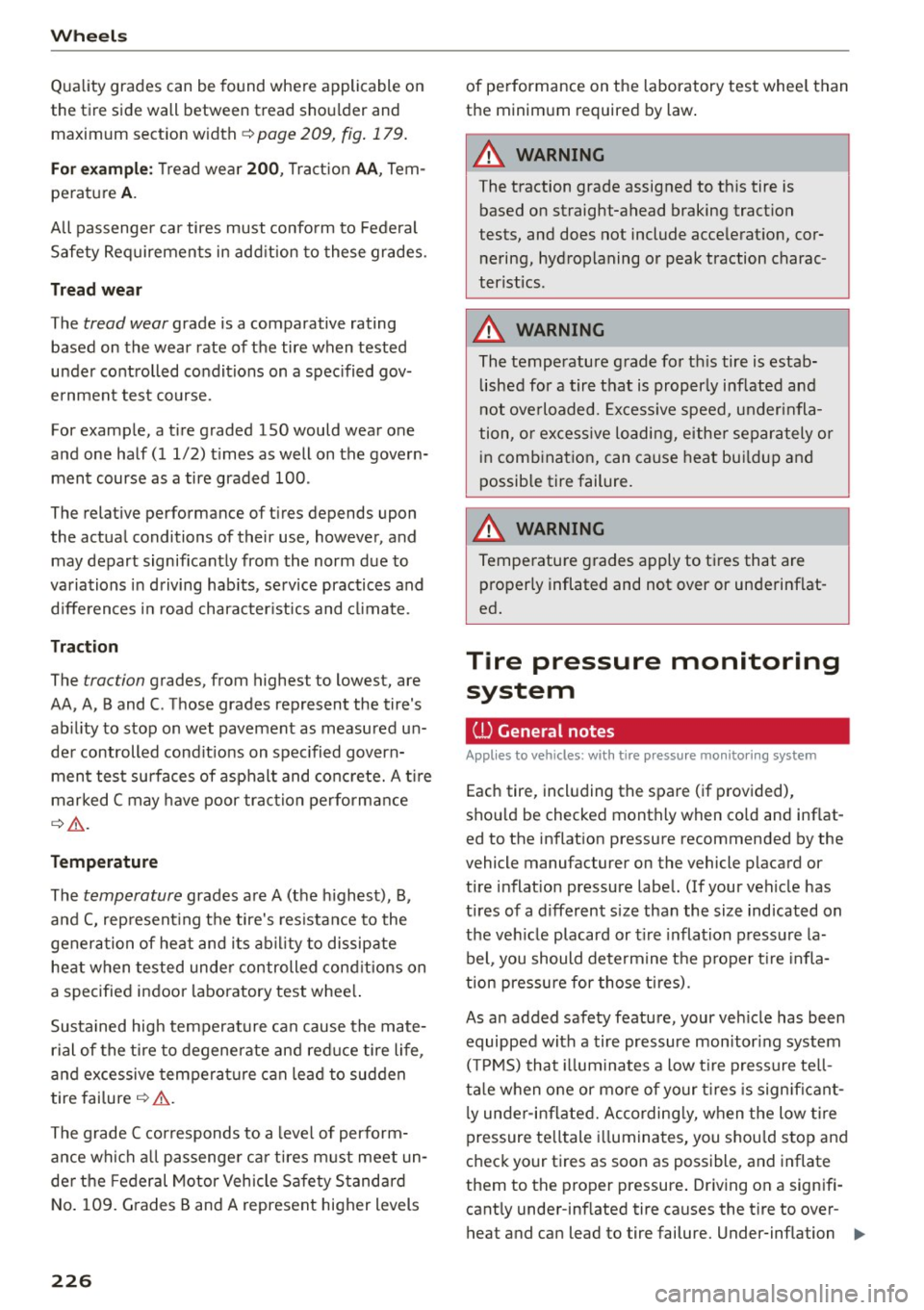
Wheels
Quality grades can be found where applicable on
the tire side wall between t read sho ulder and
maximum sect ion w idth
c::> page 209, fig . 179.
For example: Tr ead wear 200 , Tract ion AA, Tem
peratu re
A .
All passenger ca r tires must confo rm to Federal
Safety Req uiremen ts in add it ion to these grades.
Tread wear
The tread wear grade is a comparative rating
based on the wear rate of the tire when tested
unde r controlled conditions on a spec ified gov
ernment test course.
For examp le, a t ire graded 150 would wear one
and one half ( 1 1/2) t imes as well on the govern
ment course as a tire graded 100 .
The relat ive performance of t ires depends upon
the actua l conditions of their use, however, and
may depart significantly from the norm due to
variations i n driving hab its, service practices and
d iffe rences in road character istics and clima te.
Traction
The traction grades, from highest to lowest, are
AA, A , Band
C. Those grades represent the tire's
ab ility to stop on wet pavement as measu red u n
de r controlled cond it ions on spec ified govern
ment test su rfaces of asphalt and concrete. A tire
marked C may have poor traction performance
c::> &_ .
Temperature
The temperature grades are A (the highest), B,
a nd C, rep resent ing t he tire's res istance to the
genera tion of heat and its a bility to dis sipate
heat w hen tested unde r controlled cond itions on
a specified indoo r laboratory test whee l.
Sustained high temperature can cause the mate rial of the tire to degenerate and red uce tire life,
a nd excessive tempera ture can lead to sudden
tire failure
c::> &. .
The grade C co rresponds to a level of perform
ance wh ich a ll passenge r ca r tires m ust meet un
de r th e Federal Motor Vehicle Safety S tandard
No. 109. G rades Band A represent higher levels
226
of pe rformance on the laboratory test whee l than
the minimum required by law .
A WARNING -
The traction grade assigned to th is tire is
based on straight-ahead braking tract ion
tests, and does not include acce lerat ion, cor
nering, hyd roplaning or peak traction charac
teristics.
A WARNING
The temperature g rade for th is tire is estab
lished for a tire that is properly inf lated and
n ot ove rloaded. Excess ive speed, underi nfla
tion, o r ex cess ive lo adi ng, eithe r separately or
i n comb inat io n, can ca use heat bu ild up and
possible tire failure.
A WARNING
Tempe ratu re grades apply to ti res that are
properly inflated and not over or underinflat
ed.
Tire pressure monitoring system
(l) General notes
App lies to vehicl es: wi th tire p ress ure mo nito rin g system
-
Each tire, incl uding the spare (if provided),
sho uld be checked monthly when co ld and inflat
ed to the inflat ion pressure recommended by the
vehicle manufacturer on the vehicle placard or
tire inflat ion pressure label. (If your vehicle has
tires of a different s ize than the size indicated on
the ve hicle placard or t ire inflation pressu re la
bel, you should dete rm ine the p roper t ire infla
tion pressu re for those t ires).
As a n added safety feature, your ve hicle has been
equipped with a tire pressure mon itor ing system
( TP MS) that illum inates a low t ire pressure te ll-
ta le w hen o ne or mo re of yo ur ti res is sign ificant -
l y unde r-i nflated. According ly, w hen t he low t ire
pressure te lltale illuminates, you shou ld stop and
check yo ur tires as soon as possible, and inflate
them to the proper pressure . Dr iving on a signifi
cant ly under-inf lated tire causes the t ire to over
heat and can lead to tire failure. Under-inflation .,,.
Page 229 of 268

M N
ci u.. co ,...., \!) ..,.,
N ..,., ,....,
also reduces fuel efficiency and tire tread life,
and may affect the vehicle's handling and stop
ping ability .
Please note that the TPMS is not a substitute for
proper tire maintenance, and it is the driver's re
sponsibility to maintain correct tire pressure,
even if under-inflation has not reached the level
to trigger illumination of the TPMS low tire pres
sure telltale.
Your vehicle has also been equipped with a TPMS malfunction indicator to indicate when the sys
tem is not operating properly. The TPMS mal
function indicator is combined with the low tire pressure telltale . When the system detects a
malfunct ion, the telltale will flash for approxi
mately one minute and then remain continuously
illuminated. This sequence will continue upon
subsequent veh icle start-ups as long as the mal
function exists.
When the malfunction indicator is illuminated,
the system may not be able to detect or signal
low tire pressure as intended. TPMS malfunctions
may occur for a variety of reasons, including the
installation of replacement or alternate tires or
wheels on the vehicle that prevent the TPMS
from functioning properly. Always check the
TPMS malfunction telltale after replacing one or more tires or wheels on your vehicle to ensure
that the replacement or alternate tires and
wheels allow the TPMS to continue to function properly.
Wheels
If the Tire Pressure Monitoring System
indicator appears
Appl ies to vehicles : wi th t ir e p ress ure mo nito rin g system
The tire pressure indicator in the instrument
cluster informs you if the tire pressure is too low
or if there is a system malfunction.
Fig. 183 Instrument cluster: i ndicator light with message
Using the ABS sensors, the tire pressure monitor
ing system compares the tire tread circumference
and vibration characteristics of the individual
tires .
If the pressure changes in one or more
tires, this is indicated in the instrument cluster
display with an indicator light
[I] and a message .
If only one tire is affected, the location of that
tire will be indicated .
The tire pressures must be stored in the Infotain
ment system again each time the pressures
change (switching between partial and full load
pressure) or after changing or replacing a tire on
your vehicle ¢
page 228. The tire pressure moni
toring system only monitors the tire pressure you have stored. Refer to the tire pressure label for
the recommended tire pressure for your vehicle
r=> page 219, fig . 182.
Tire tread circumference and vibration character
istics can change and cause a tire pressure warn
ing if:
- the tire pressure in one or more tires is too low .
- the tire has structural damage.
- the tir e was replaced or the tire pressure was
changed and it was not stored ¢
page 228.
-the spare t ire* is installed.
Indicator lights
[I] Loss of pressure in at least one tire¢.& .
Check the tires and replace or repair if necessary .
liJJ,-
227
Page 230 of 268

Wheels
Check/correct the pressures of all four tires and
store the pressure again in the Infotainment sys
tem
c!) page 228.
mm (Tire Pressure Monitoring System) Tire pres
sure: System malfunction!.
If m appears after
switching the ignition on or while driving and the
[I] i ndicator light in the instrument cluster
blinks for approximately one minute and then
stays on, there is system malfunction. Try to
store the correct tire pressures
c:> page 228 . If
the indicator light does turn off or turns on again
after a short period of time, drive to your author
ized Audi dealer or qualified repair facility imme
diately to have the malfunction corrected.
A WARNING
-If the tire pressure indicator appears in the
display, reduce your speed immediately and
avoid any hard steering or braking maneu
vers. Stop as soon as possible and check the
tires and their pressure.
- The driver is responsible for maintaining the
correct tire pressure. You must check the
tire pressure regularly.
-Under certain conditions (such as a sporty
driving style, winter conditions or unpaved
roads), the tire pressure monitoring system
indicator may be delayed.
- Do not use run-flat tires on your vehicle. Us
ing them when not permitted can lead to
vehicle damage or accidents.
(D Tips
- The tire pressure monitoring system can al
so stop working when there is an ESC mal
function.
- Using snow chains may result in a system
malfunction.
- The tires with the identification "AO" or
"RO"
c:> page 216 have been matched with
your Audi tire pressure monitoring system.
We recommend that you use these tires.
228
· Storing tire pressures
App lies to vehicles: wit h tire press ure mo nitor ing system
If the tire pressure changes or a tire is replaced,
it must be confirmed in the Infotainment sys
tem .
.,. Make sure before storing that the tire pressures
of all four tires meet the spec ified values and
are adapted to the load
c!) page 219.
.,. Switch the ignition on.
.,. Select: the
I CARI function button > Tire pres
sure monitoring
control button. Or
.,. Select: the
I CARI function button > Car Sys
tems*
control button > Servicing & checks >
Tire pressure monitoring.
(D Tips
Do not store the tire pressures if snow chains
a re i nsta lied.